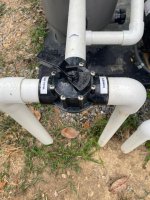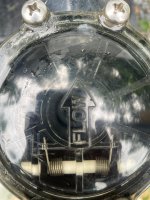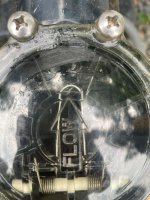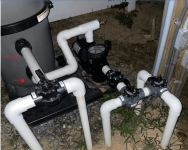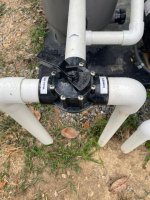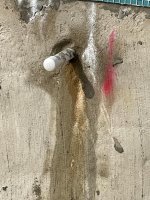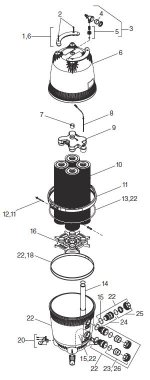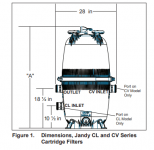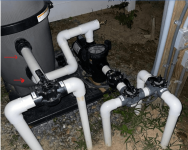If the filter manifold isn’t seated properly there wouldn’t be any restriction in the filter.
Pressure gauge indicates zero during normal operation???
- Thread starter KCD
- Start date
You are using an out of date browser. It may not display this or other websites correctly.
You should upgrade or use an alternative browser.
You should upgrade or use an alternative browser.
What is your rationale for moving the check valve? If the check valve is between the pump and the filter, water could drain from the pump to the pool; and you can end up with problems trying to prime the pump.I would move the check valve from in front of the pump to after the pump between the pump and filter.
You can get a vacuum gauge to measure the vacuum pressure at the pump's front drain plug port.
Be careful not to overtighten the gauge or the plastic can crack.
Regarding your analysis below that states "if the gauge is more than 9.38 feet above the water, the gauge might not register," what would it be for different assumptions: flow rate of 40 gpm, 2" return, 2x1" return, 30' of 2" piping, and 70' of 1" piping. These conditions would better suit my pool.
If we assume a flow rate of 80 GPM, that puts the filter head loss at about 10 feet.
The flow will dynamically balance between the 2" return and the 1.5" return and about 25 GPM will go to the 1.5" line and about 55 GPM will go to the 2" line for a head loss of about 4 feet.
That makes a total of 14 feet of head loss.
2 psi is about 4.62 feet of head.
14 - 4.62 = 9.38 feet.
So, if the gauge is more than 9.38 feet above the water, the gauge might not register.
You need to be sure which is the inlet and which is the outlet of the filter. I can't see it in your photos. Your pump is pumping water into the bottom fitting. Just make sure that is truly the inlet and not the outlet. Filters differ and we have seen them accidentally plumbed backward.How would I determine if it is out of plumb and how would it cause zero pressure?
If we assume a flow rate of 40 GPM, that puts the filter head loss at about 4 feet.
The flow will dynamically balance between the 2" return and the 1.5" return and about 20 GPM will go to the 1" lines and about 20 GPM will go to the 2" line for a head loss of about 5 feet.
That makes a total of 9 feet of head loss.
2 psi is about 4.62 feet of head.
9 - 4.62 = 3.38 feet.
So, if the gauge is more than3.38 feet above the water, the gauge might not register.
My gauge is about that so now it makes sense.
The flow will dynamically balance between the 2" return and the 1.5" return and about 20 GPM will go to the 1" lines and about 20 GPM will go to the 2" line for a head loss of about 5 feet.
That makes a total of 9 feet of head loss.
2 psi is about 4.62 feet of head.
9 - 4.62 = 3.38 feet.
So, if the gauge is more than3.38 feet above the water, the gauge might not register.
My gauge is about that so now it makes sense.
The pump is not that high, so the priming should be quick and easy.What is your rationale for moving the check valve? If the check valve is between the pump and the filter, water could drain from the pump to the pool; and you can end up with problems trying to prime the pump.
You can install a 2-way valve if you want to shut the line for service.
In fact, the main check valve body is probably the same for the check valve and the regular valve so all you have to do is pull out the check valve part and install the regular valve part.
The problem with a check valve on a suction is head loss and debris like leaves getting stuck in the check valve flap.
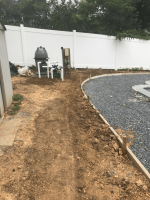
I see a 2" return and a 1.5" return.Regarding your analysis below that states "if the gauge is more than 9.38 feet above the water, the gauge might not register," what would it be for different assumptions: flow rate of 40 gpm, 2" return, 2x1" return, 30' of 2" piping, and 70' of 1" piping. These conditions would better suit my pool.
Where are the 1" returns?
The flow will probably be between 40 GPM and 110 GPM.
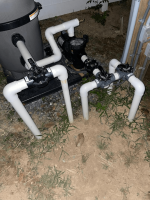
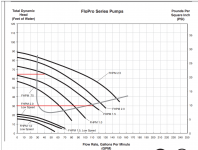
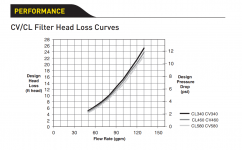
System component.......50 GPM Head loss......60 GPM Head loss.....70 GPM head loss.........80 GPM head loss.....100 GPM head loss
Filter.......................................5 feet....................................6 feet.................................8 feet...............................10 feet.........................14 feet
Suction.................................2.1..........................................2.9.........................................3.9 feet...........................5 feet............................7.5 feet
Return..................................2.1..........................................2.9.........................................3.9 feet...........................5 feet............................7.5 feet
Total......................................9.2.......................................11.8.......................................15.8 feet.........................20 feet.........................29 feet
Based on the low system head loss, I would expect about 100 GPM and a filter pressure of about 7 psi.
If we assume that the gauge is accurate and the pressure is 2psi, that would imply a flow of about 65 GPM, which would point to a problem on the suction side.
Does the check valve flap open and close smoothly when the pump is turned on and off?
Can you show a close up looking into the check valve?
Can you show a close up looking into the check valve?
The pump is not that high, so the priming should be quick and easy.
You can install a 2-way valve if you want to shut the line for service.
In fact, the main check valve body is probably the same for the check valve and the regular valve so all you have to do is pull out the check valve part and install the regular valve part.
The problem with a check valve on a suction is head loss and debris like leaves getting stuck in the check valve flap.
You are right. Priming the pump should not be a problem with the check valve between the pump and the filter. There is another valve there between the pump and pool that can be shut to prevent possible flow back to pool. Debris in the check valve could be the current problem with lower flow and head loss causing low /no pressure indication at the filter housing.
The 2" return splits into two 1" returns underground. The 1.5" is the cleaner return. See pic below. The check valve seems to be in good shape. See pics. The valve is partially closed on the cleaner return to obtain a reading of about 3 psi (baseline pressure) on the pressure gauge. When the pressure reaches about 15 psi, filter is to be cleaned per manufacturer's spec.The pump is not that high, so the priming should be quick and easy.
You can install a 2-way valve if you want to shut the line for service.
In fact, the main check valve body is probably the same for the check valve and the regular valve so all you have to do is pull out the check valve part and install the regular valve part.
The problem with a check valve on a suction is head loss and debris like leaves getting stuck in the check valve flap.
View attachment 426892
I see a 2" return and a 1.5" return.
Where are the 1" returns?
Attachments
Last edited:
1" would be unusual.The 2" return splits into two 1" returns underground.
Most likely, it splits into (2) 1.5" pipes.
Do you have pictures of the split point?
Maybe check inside the suction valves.
Maybe put a vacuum gauge on the pump.
Is the check valve pointed in the correct direction?
You can see the words in this pic below.
Attachments
Check valve is installed correctly. No picture of the split joint but there is one of the 1" return penetrating the pool wall during construction. See pic below. I may suggest to the PB about checking inside the suction valves and putting a vacuum gauge on the pump. So far they did a leak test and replaced the pressure gauge without any luck.1" would be unusual.
Most likely, it splits into (2) 1.5" pipes.
Do you have pictures of the split point?
Maybe check inside the suction valves.
Maybe put a vacuum gauge on the pump.
Is the check valve pointed in the correct direction?
Attachments
If you are referring to the filter cartridge, no. The cartridge does not have a top or a bottom. Water pass through the cartridge from the outer to the inner area of the tank and out the upper area. Which filter part are you referring to?Does the filter say outlet on the top port going out of the filter?
Attachments
- Aug 20, 2020
- 7,785
- Pool Size
- 27000
- Surface
- Plaster
- Chlorine
- Salt Water Generator
- SWG Type
- CircuPool RJ-60
He saying the outside of the cartridge filter should be marked for which pipe is “in” and “out”. It’s somewhat common for those to get plumbed backwards.If you are referring to the filter cartridge, no. The cartridge does not have a top or a bottom. Water pass through the cartridge from the outer to the inner area of the tank and out the upper area. Which filter part are you referring to?
Thread Status
Hello , This thread has been inactive for over 60 days. New postings here are unlikely to be seen or responded to by other members. For better visibility, consider Starting A New Thread.


